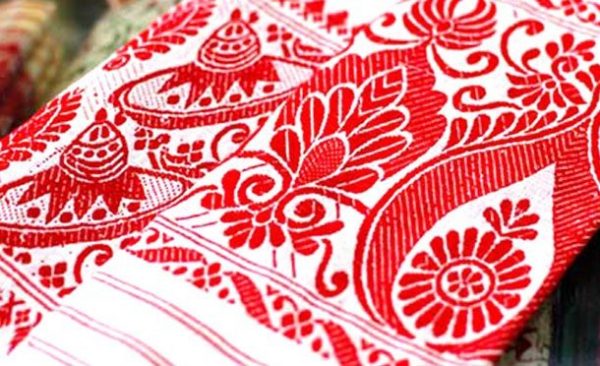Gamosa, a symbol of the rich culture and heritage of Assam is one of its oldest handloom products. Also known as phali in the ancient days, this textile has been held in high esteem and represents the spirit, unity and history of the people of Assam. Essentially, it would appear that the gamosa was a fabric used to wipe the face and body after taking a bath and hence, also came to be called mukhosa.
Gamosa with red anchu (lengthwise border and crosswise border with design) was used as a head gear during the reign of the Ahom kings. Gamosa was an important part of the Bhakti movement advocated by the saint, Srimanta Sankardev. This traditional plain weave is a vital component in all ceremonies and rituals be it religious, marriage, meetings, welcoming elders and guests, Bihu festivals and feasts. No important work is deemed complete unless the gamosa is presented in the appropriate manner.
Gamosa with red border and floral motifs on both ends are used by men and women as head gear and wrapped around the waist during the Bihu festivals. It is very common to see the gamosa hung around the neck or placed on the shoulders while going to the Naamghar (temple). The mandap or altars of the temple are decorated with the gamosa with floral motifs along with words of Krishna, Hari and Rama as butties all over the body of the gamosa.
Guests are welcomed with an offering of a gamosa and tambul (betel nut). Elders are gifted gamosas during the Bihu festivities. Even today, it is used as a cloth to wipe the body after taking a bath, to keep betel nut and used as a head gear.
The different types of gamosa are – uka (Uka means plain and meant for daily usage. It has red borders on both sides without any design and used for rituals, pujas and to wipe the body after a bath.), phulam (Has intricate flowers of the spring season called Bhomoka Phool in red colour as well as traditional Assamese jewellery designs, birds, animals, dancing girls and boys, boys and girls of the fishing community and others. This is gifted to elders, guests, temples and priests.), bihuwan (Gifted to a family member at the time of the Bihu celebration. Bihuwan with large red motifs are given by young girls to their beloved, by the mother-in-law to her son-in-law and is considered to be a ceremonial gamosa.), tioni (Used by farmers and rural Assam), pani (Worn by the elders in rural Assam), anakota (A single piece of gamosa woven at one time used by the bride and bridegroom on their wedding day while performing rituals), telos (Used to wipe the bodies of the bride and bridegroom after they are anointed with a paste of black gram and turmeric along with mustard oil and washed with holy water at the time of their marriage), dora or jor (Decorated with gold threads with both edges finished with a special yarn called keresi. There are floral motifs on both sides and this ceremonial gamosa is sent by the bride’s party to the grooms.) and xadharon (Meant for daily use, household work and fishing).
The size of the gamosa varies depending on its use but is approximately about 1.30 to 1.85 metres in length and about 0.60 to 0.85 metres in width. The traditional red colour called anchu is taken from the local plant with the same name.
Gamosa is a plain weave textile with a white or cream colour body. The lengthwise border or pari generally has three red strips known as sotia and has three thin lines called as pooli in between the sotia. Floral motifs in crosswise borders are used between the kasori (creeper with floral motif). The portion between the designs of the two crosswise borders is called khioni. The unwoven lengthwise yarns at both ends of the gamosa is known as dahi.
Untwisted and unbleached pure cotton yarn called kecha suta is used for the body. Red untwisted yarn is used for lengthwise border and design at both ends. Silks like mulberry, muga, tasar and art are also used to weave the ceremonial gamosas.
Fly shuttle loom or country loom is traditionally used to weave the gamosa. In the ancient days, bamboo sticks were used as measuring sticks and placed on the warp (lengthwise yarn) before passing the weft (crosswise yarn) through the warp to create the designs. These days jacquard machines are used to produce both traditional and contemporary designs.
A 1,455.30-metres long Gamosa made by twelve weavers with historical motifs of Rang Ghar, Majuli, Srimanta Sankardev, Bhupen Hazarika and the one-horned rhino displayed in Delhi in 2016 made its entry into the Guinness Book of World Records for being the longest handwoven piece of cloth.
The iconic gamosa was awarded the Geographical Indication Tag (GI) in 2019.
Written by Lakshmi Subramanian
* Photos are only symbolic (Taken from public domain/internet and any copyright infringement is unintentional and regrettable)


Leave a comment